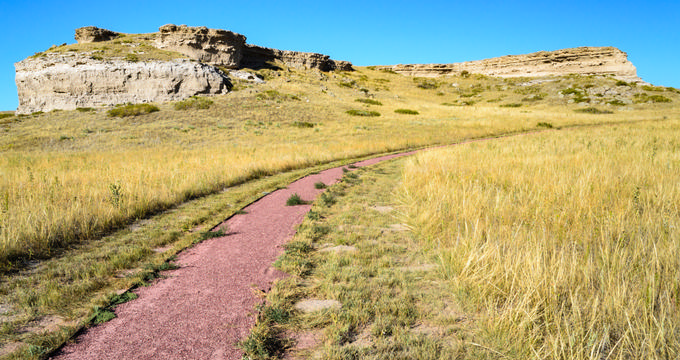Step back 20 million years at the Agate Fossil Beds National Monument, where the Miocene Epoch comes to life. Located in the vast High Plains of western Nebraska, this hidden gem preserves one of the world’s richest fossil beds and showcases the cultural ties between the Cook family and the Lakota people.
Recommended For
Fossil Hunters: Paleontology enthusiasts eager to see world-class fossil exhibits and prehistoric bone beds.
History Buffs: Visitors interested in the cultural ties between early ranchers and the Lakota people.
Families & Hikers: Families with children seeking outdoor fun, fossil-themed activities, and educational programs.
What to Expect
- Visitor Center: Watch a 12-minute film, view life-sized replicas of extinct mammals, and explore two galleries including the Lakota-focused James Cook Collection.
- Fossil Exhibits: Replica fossils and the famous “bone bed” reveal life during the Miocene epoch.
- Hiking Trails: Two trails—Daemonelix Trail (1.6 miles) and Fossil Hills Trail (2.7 miles, wheelchair-accessible)—offer scenic walks with fossil and historic views.
Fossil & Cultural Highlights
- Prehistoric Creatures: Discover fossils of Menoceras (rhinoceros), Moropus (horse relative), and the massive Dinohyus (“terrible pig”).
- Daemonelix Trail: View in-situ fossil exhibits of the dry-land beaver (paleocastor) and take in panoramic views of the High Plains.
- Fossil Hills Trail: Explore Carnegie Hill and University Hill, where famous bone beds were first confirmed.
Human Connections
- James Cook: The rancher who discovered the fossils and welcomed paleontologists to Agate Springs Ranch in the late 1800s.
- Harold Cook: James’ son and a self-taught paleontologist whose homestead cabin is on the National Register of Historic Places.
- Lakota Legacy: The James Cook Collection includes rare Lakota artifacts such as Red Cloud’s moccasins and Crazy Horse’s whetstone.
Educational Experiences
- Ranger Programs: School visits, fossil kits, and talks about Miocene mammals and the region’s rich heritage.
- Junior Ranger Activities: The Visitor Center offers hands-on exhibits and badge-earning fun for kids.
Plan Your Visit
- Established: Officially designated as a National Monument in 1997.
- Location: 301 River Road, Harrison, NE 69346
- Phone: 308-665-4113
- Accessibility: Paved trails and accessible exhibits make it easy for all visitors to enjoy.
Plan Your Trip


